Market Day in Provence: The Vaucluse and Beyond
The time is 8:30 on a Tuesday morning in mid-October. We are at the Vaison-la-Romaine market and a chill is in the air. Vendors bundled in woollen scarves warm their hands on steaming cups of coffee behind heaped tables of produce: squat, grey-green pumpkins, sliced to reveal fiery orange flesh; colourful heirloom tomatoes; stacks of leeks; herbs spilling out of baskets; feathery heads of frisée lettuce…
Among the butchers, fromagers and fishmongers, a row of smaller, covered stands offer the local bounty: late-season figs and raspberries; glossy chestnuts; and wild cèpes still covered with earth. Lavender is everywhere, neatly tied in bundles or brimming from bowls to be scooped into sachets.
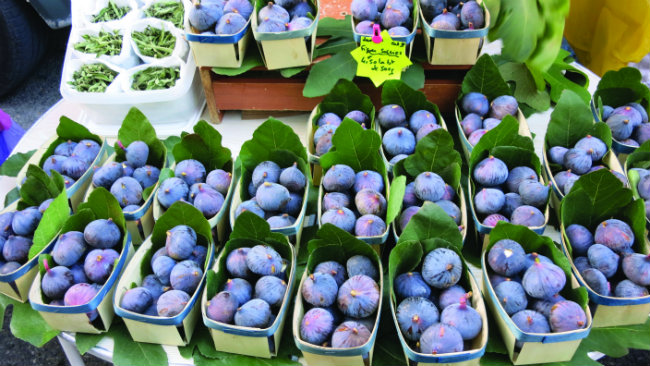
figs at the market in Vaison. Photo: Jennifer Ladonne
We are among the early risers at the market, which is the largest and oldest in the region. Lying in the shadow of Mont Ventoux and the vertiginous cliffs of the Dentelles de Montmirail mountain range, Vaison-la-Romaine marks the farthest reaches of Provence’s Vaucluse département. Its postcard-perfect setting between two steep hillsides bisected by the Ouvèze River and rejoined by a gracefully arched first-century Roman bridge draws a steady stream of tourists that come for its superb Roman vestiges, perched medieval old town and out-of-time allure – quite enough to justify a trip.
But those in the know plan their visit to coincide with a Thursday morning, when the sleepy town comes vividly to life in a panoply of stalls over half a dozen streets, including the town square, overflowing with the largesse of this fertile river valley.
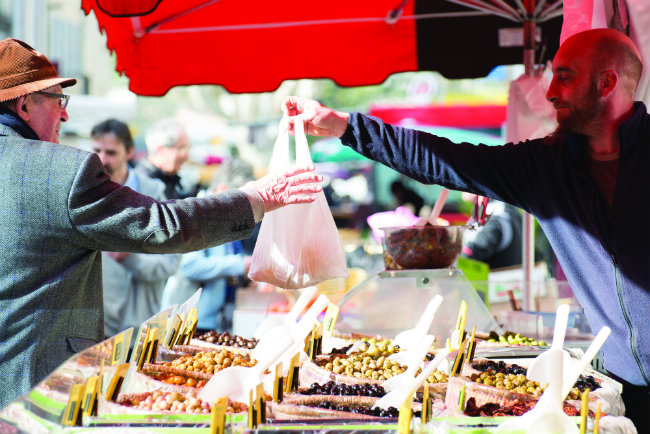
The Vaison market. Photo: OT Vaison/ L. Pamato
Stopping to admire bottles of colourful orchard-fresh nectars – golden Reine Claude plum, sour cherry, strawberry, red peach – we notice an unmistakable gnarly black knob the size of a small child’s fist laid out unceremoniously on a paper towel.
“Truffles already?” we ask hopefully. “An early one, not fully grown but still good. The dogs were eager,” we are told. A short bargaining session and tuber melanosporum, the prized jewel of France’s lower regions, is ours for €15.
Vaison is a model among markets, a vibrant, living amalgam of the traditional and the modern, farmers and sellers, craftspeople and junk dealers. Although outdoor markets are a fact of life in every city, town and village in France, not all are created equal. Most are dominated by what the French call “resellers”, those who buy their industrially grown and often imported fruits and vegetables at huge wholesale markets, like Paris’s Rungis (the largest such market in the world), and don’t feature so many farmers who sell what they grow themselves.
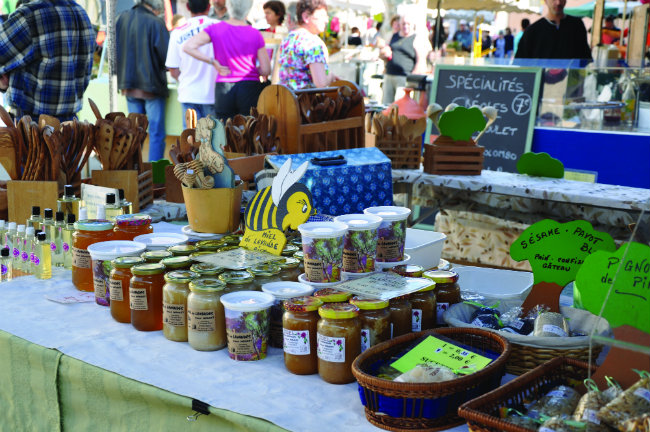
Local honey on sale at Forcalquier market. Photo: OT Forcalquier
“Vaison market’s size and the diversity and quality of its products make it an essential stop in the region. This is a typical market with many authentic products from local farmers and artisans. It is a journey for the senses,” says Lise Trincaretto, director of the Vaison tourist office, who arrived four years ago from the north of France and fell hard for the town and region. “Life here is like the market: slower-paced, warmer, more human.” Though this important wine-producing region is teeming with picturesque villages, each more charming than the next, and each with its weekday and Sunday market – Séguret, Gigondas, Beaumes-de-Venise, Crestet, Le Barroux, to name a few – Vaison “is one of the oldest continuous markets in Provence, dating back to 1483 and stopping only during the Revolution,” specifies Trincaretto.
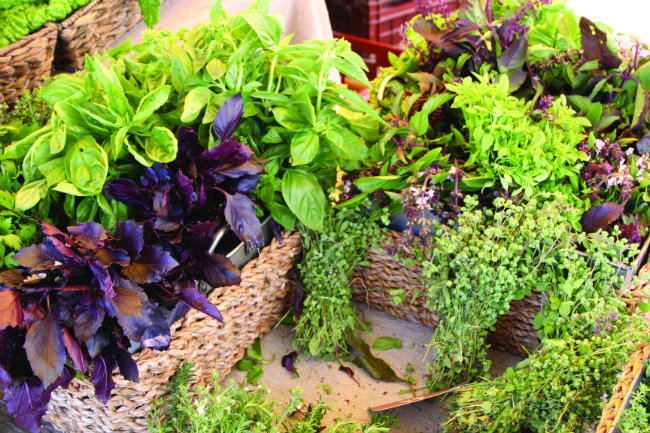
herbs for sale at the Arles market. Photo: OT Arles
Yet compared to some Provençal villages, Vaison market’s late-medieval roots seem positively arrivistes. Farther south, over the vineyard-cloaked fields and valleys of the lower Vaucluse, all ancient roads once crossed at Carpentras. A larger town, Carpentras may not have the condensed charm of the tiny villages that cling attractively to precipices, but its market – whose first mention dates to the rule of Emperor Nero, in the 1st century BC, and whose medieval presence can be traced to 1155 – is as lively and characteristic as any in Provence. So much so, that French anthropologist Michèle de La Pradelle used it as a benchmark in her study Market Day in Provence.
“To satisfy both buyer and seller, the marché forain (open air market) depends on establishing an ‘economy of seduction’,” says De La Pradelle, where the goods, no matter their origin, create at least an illusion of farm-to-table goodness. And the atmosphere is about enjoyment. For De La Pradelle, the market is a great equaliser in French society, a place where markers of social class are irrelevant and everyone is governed by the same rule: the pursuit of pleasure. “Here one does not show sorrow, complain or fidget nervously, unless in imitation of the busy stallholder for a laugh. Nothing should interfere with the spectacle of the vendor’s joy of selling at the market.”
Nowhere in France are you plunged more quickly or profoundly into village life than at the local market. And there is nowhere like Provence for experiencing first-hand the social customs surrounding market day: to take your time, banter, laugh, wander, admire, and end up at the café.
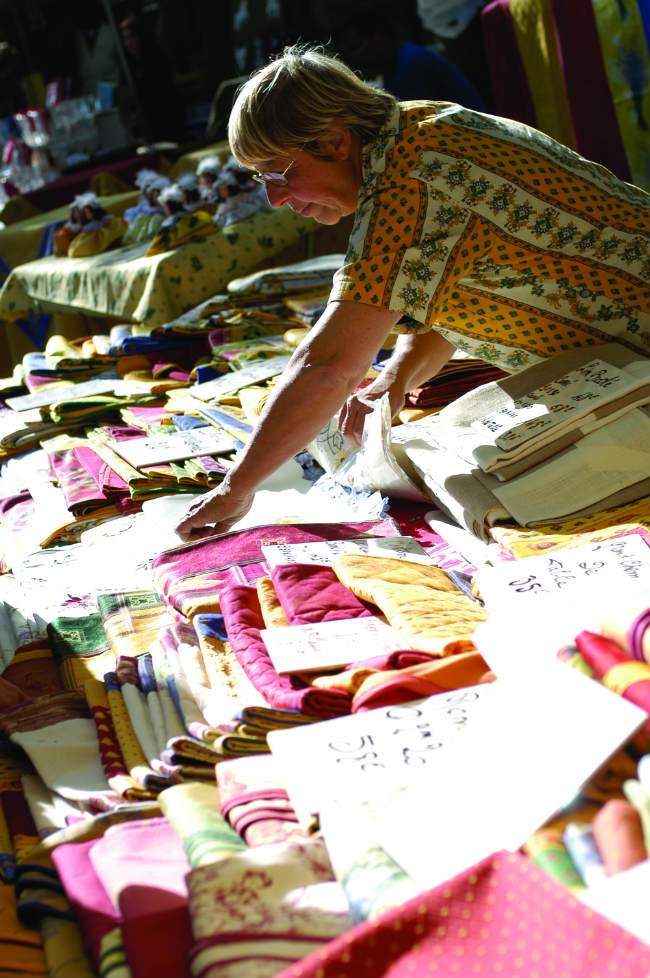
Linen for sale at the market in Arles. Photo: OT Arles
Market day with Catharine Cary, an American artist who has lived between Paris and the lovely perched village of Venasque for the last 10 years, is a case in point. Half an hour in the dappled shade of the tree-lined Carpentras market and we’ve yet to spend a single sou, as Catharine is greeted, waved to and stopped for a quick conversation around the philosophy of art and the state of US politics. Vendors and buyers take their time, joke, delight in the ritual. Though Cary could shop in any number of nearby markets, for the social interaction and ritual, as well as sheer abundance, this market has no equal.
“The Carpentras market impresses with its winding size and unending variety: the old man hiding behind bouquets of mint, coriander and parsley, the sweet Jamaican woman selling varieties of pepper and vanilla – all of it mixed in with traditional Provençal pottery and too much lavender!” laughs Cary.
Carpentras’ fortunate position in the centre of Provence’s most fertile growing region assures a year-round cornucopia: in springtime, succulent Appellation d’Origine Contrôlée strawberries and Monts de Venasque cherries; in summer, Ventoux muscat grapes, apricots and black Caromb figs; in autumn, local saffron; and in winter the Carpentras truffle market is the largest and most visited in the area, enticing gourmets from all corners of France. Those with a sweet tooth seek out the famous whole candied fruits (a regional speciality that ranges from tiny tart cherries to whole melons), huge cakes of nougat studded with local almonds and the Carpentras berlingot, a striped pyramid-shaped hard candy that dates to the 13th century. Not to mention the abundant AOC Rhône Valley wines.
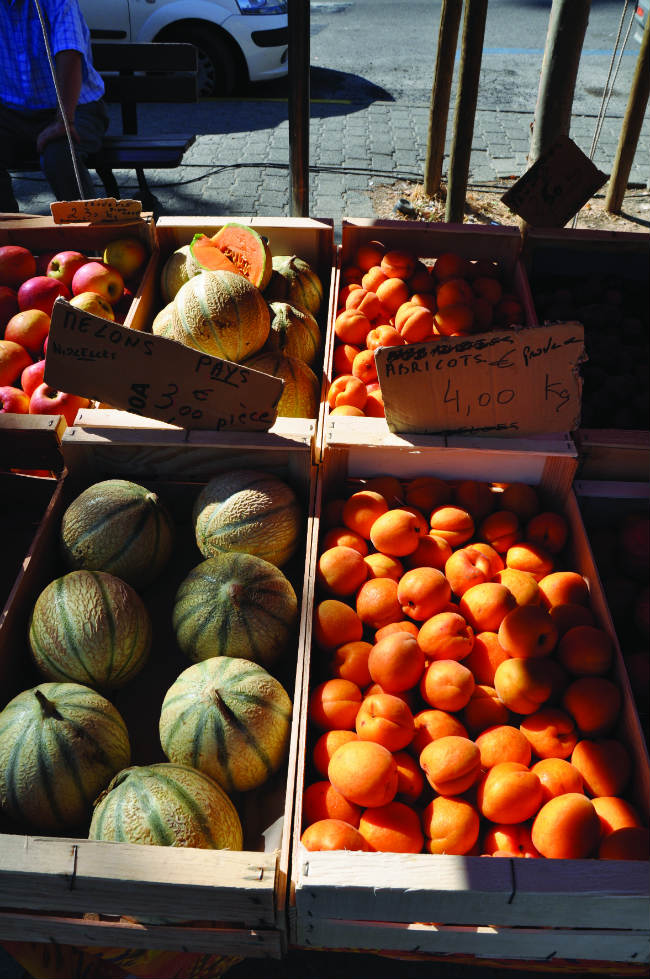
Apricots at the Forcalquier market. Photo: OT Forcalquier
A fifth-century manuscript in the city archives describes the Arles market thus: “Everything from the Orient, and from Arabia, penetrating perfumes, all that is produced in fecund Assyria, meets in Arles in greater abundance than its country of origin.” Though somewhat less exotic today, the Arles market still evokes the bazaar spirit. Stretching for three kilometres under the generous plane tree-lined Boulevards de Lices and Clémenceau, this teeming market of 400-600 commerçants, depending on the season, assembles all the culinary riches of Provence, as well as local pottery, textiles, essential oils, flea market finds and a small antiques market. Arles is also one of the few markets with a thriving organic section, just in front of the tourist office.
Besides the meat, fish and cheese sellers common to every market, Arles has a picturesque abundance all its own: aromatic spices spill from open-air baskets, local producers offer lavender and herb-scented honeys, fruit-flavoured vinegars, homemade confiture and juices, cured meats and saucissons and long braids of garlic. But olives in every form are the star of the show: fresh-pressed oils, dozens of varieties scooped from vats or wooden bowls, some stuffed with peppers, preserved lemon, almonds or whole garlic cloves or puréed into green or black tapenade. Specialities from the wilds of the nearby Camargue abound: anchoïade, a zesty mix of anchovies, garlic, capers and Herbes de Provence puréed in olive oil and taureau sausages from the Camargue bull. The influence of Gypsy and Occitan cultures is palpable, if only in a revived form.
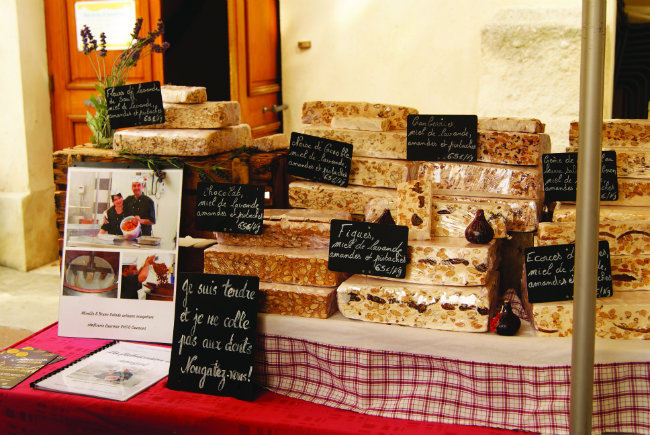
Nougat for sale at the St Remy market. Photo: OT St Remy de Provence
Market basket full (plastic is a no-no), it’s time to head to the local café for your petit blanc. Or, as this is Provence, a juicy rosé will do just fine. And if wine before noon is not on the agenda, just chalk it up to a sociological experience.
This north-south route, from Vaison-la-Romaine to Arles by way of Carpentras, is just one of a dozen possible trajectories, each with its share of scenic markets. The larger, more distinctive markets in the area that are well worth a visit include beautiful Saint-Rémy-de-Provence and elegant Aix-en-Provence. L’Isle-sur-la-Sorge’s wall-to-wall antiques shops and Sunday flea market are an antique lover’s dream (though not necessarily a bargain hunter’s). The scenic perched villages of the Luberon mountain range – Menerbes, Lacoste, Bonnieux, Gordes, Roussillon Buoux, etc – all have a market day, but standouts include Gordes for atmosphere and charm; Apt for size, variety and authenticity; and Forcalquier for its artsy, free-spirited vibe.
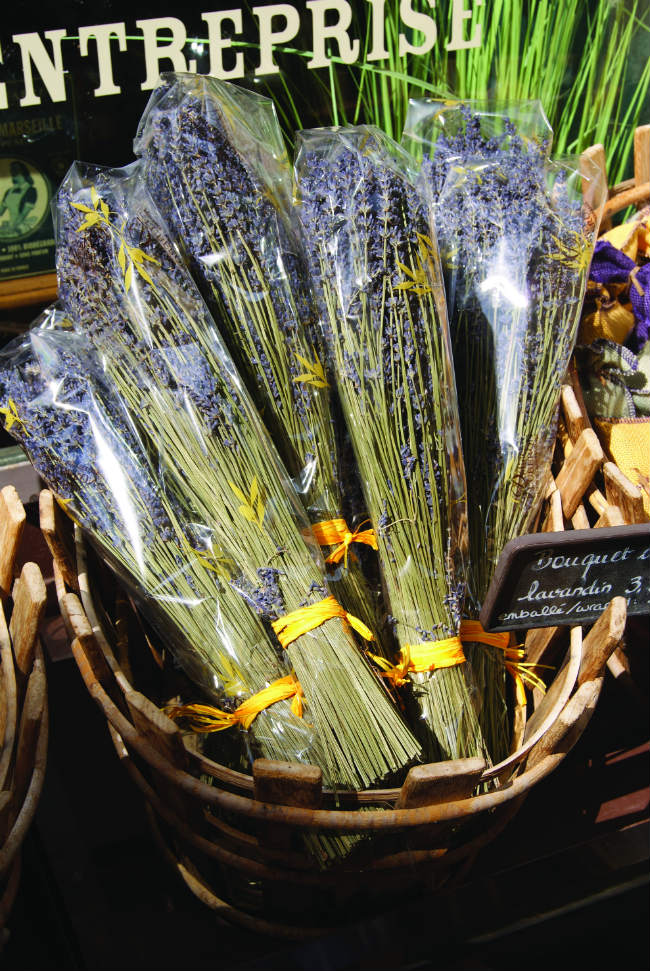
Lavender for sale at the market in Saint-Rémy-de-Provence. Photo: OT Saint-Rémy-de-Provence
Other Markets Worth a Detour
While every village in Provence has its own market day, here are a few standouts:
Apt: The largest market in the Luberon, Apt’s lively and colourful Saturday morning market follows the old town’s sinuous lanes, culminating in the Cours Lauze de Perret – also the site of the famous Tuesday marché paysan, (farmers’ market), limited to local farmers only. Here you’ll find anything and everything that can be found in Provence.
Forcalquier: Dating to the Middle Ages, Forcalquier’s monday market – centred in the old town square near the tourist office and across from the church – is a Provence institution and reflects the town’s bohemian vibe. A centre for artists and artisans, Forcalquier’s market offers a great opportunity to stock up on artisanal products you may not find elsewhere.
St-Rémy-de-Provence: The Wednesday morning market in beautiful Saint-Rémy is a goldmine for Provençal specialities and reflects the more refined atmosphere of the town in its selection of crafts, handmade jewellery and local specialities.
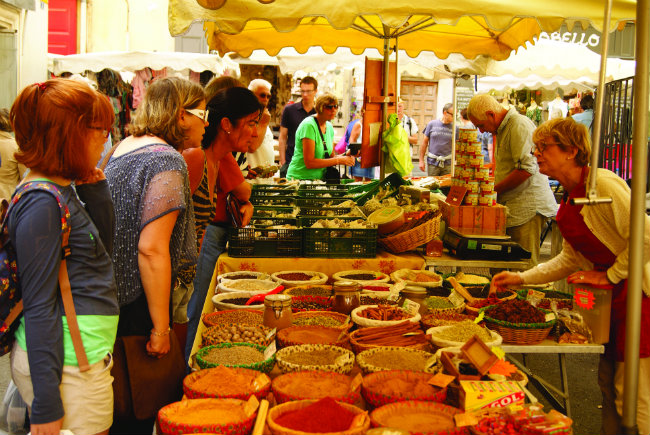
The market in St-Rémy-de-Provence. Photo: OT St-Rémy-de-Provence
Gordes: Every Tuesday morning this gorgeous perched village sees one of the area’s most delightfully scenic markets in the cobbled town centre near the château. You’ll find all the usual Provençal delicacies along with linens, potpourri, soap and much more, and views for miles.
Coustellet: For a bit of local colour, Coustellet’s Sunday morning marché pays an features seasonal bounty from more than 80 local producers. You’ll find the famous local cherries, strawberries, artichokes, asparagus, olive oil and so much more, all with the assurance that you’re buying local.
L’isle-sur-la-Sorgue: Called the Venice of Provence, there’s nowhere in France quite like bustling L’isle sur la Sorgue, home to more than 300 antiques dealers lining the town’s scenic river, canals and winding streets. On Sunday market day you’ll also find all the bounty of Provence in stalls lining the central town square and the river. Once a year, in August, the annual Marché Flottant features farmers in costume selling their wares from traditional flatboats. The next weekend is the International Art and Antiques Fair, with more than 200 stands in addition to the town’s 300 shops.
Aix-en-Provence: Every day is market day in exquisite Aix, one of Provence’s most picturesque and best-loved markets. On Tuesday, Thursday and Saturday the grand marché stretches through the old town from the Place des Prêcheurs, near the old Palais de Justice. Held on the same days, the flower market at place de l’Hôtel-de-ville is another favourite. And in July and August only an antiques market occupies the place Jeanne d’Arc and the Cours Sectius.
From France Today magazine
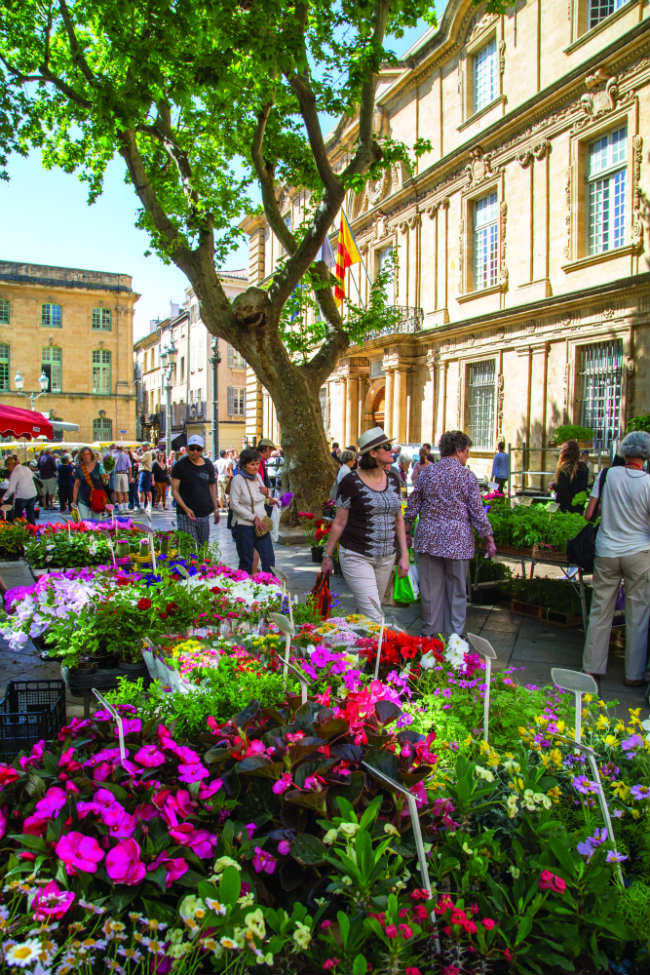
The flower market in Aix-en-Provence. Photo: OT Aix-en-Provence/ Sophie Spiteri
Share to: Facebook Twitter LinkedIn Email
Leave a reply
Your email address will not be published. Required fields are marked *

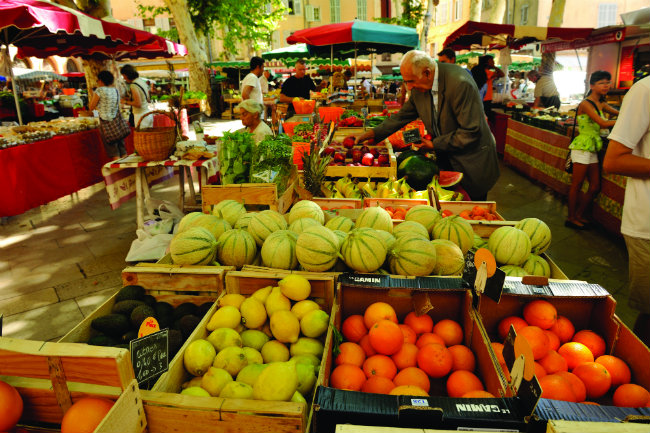




REPLY
REPLY